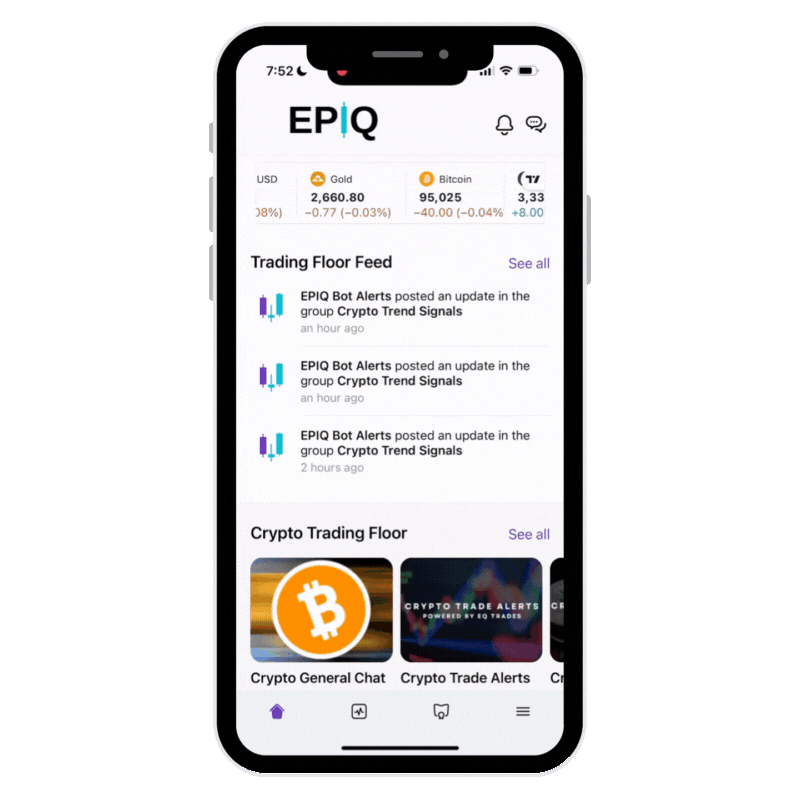In the world of crypto trading, mastering the order book can give traders a significant edge. The order book is a real-time ledger of buy and sell orders on an exchange, offering valuable insights into market sentiment, liquidity, and potential price movements. Understanding how to interpret and trade using order book data can help traders make informed decisions, optimize trade execution, and improve profitability.
If you’re looking to level up your crypto trading skills, EPIQ Trading Floor provides an exclusive membership with real-time trade signals, market analysis, and one-on-one coaching. Use code “BLOG” at checkout for a 10% discount and take advantage of our risk-free 3-day trial—cancel within 72 hours without being charged.
What Is a Crypto Order Book?
A crypto order book is an electronic list of buy and sell orders for a specific cryptocurrency, maintained by exchanges to facilitate trading. It displays three essential components: bid prices, ask prices, and trade volume. The bid price represents the highest price buyers are willing to pay for an asset, while the ask price is the lowest price sellers are willing to accept. The difference between the highest bid and the lowest ask is called the spread, and it indicates market liquidity. A tighter spread suggests a more liquid market, while a wider spread may signal lower liquidity and increased volatility.
The order book also consists of limit orders (orders placed at specific price levels) and market orders (instant orders executed at the best available price). By analyzing the depth of the order book, traders can assess buying and selling pressure, detect potential price breakouts, and execute more effective trades.
How to Read an Order Book
A typical order book is divided into two sides:
- Buy Orders (Bids): These are placed by traders looking to buy the asset. The highest bid appears at the top, and orders decrease in price as you go down.
- Sell Orders (Asks): These are placed by traders selling the asset. The lowest ask is listed at the top, with prices increasing as you move downward.
The order book depth is a crucial indicator of market sentiment. A deep order book with many buy and sell orders suggests strong liquidity, while a thin order book may indicate volatility and potential price manipulation.
Large orders (often referred to as “walls”) are another key element to watch. A significant buy wall means that buyers are placing large buy orders at a specific price, signaling strong support. Conversely, a large sell wall indicates resistance, as sellers are looking to offload their holdings at a particular level.

Using the Order Book to Execute Smart Trades
Traders can leverage order book data to improve trade execution. Here are some practical strategies:
1. Spotting Support and Resistance Levels
By analyzing buy and sell orders, traders can identify support (a price level where demand is strong) and resistance (a price level where selling pressure increases). If a large buy wall exists at a particular price, it indicates strong support, making it a potential entry point. Similarly, a large sell wall suggests resistance, where traders might consider taking profits or placing stop-loss orders.
2. Identifying Market Manipulation
Some traders and institutions use spoofing and order book layering to manipulate the market. Spoofing involves placing large fake orders to create artificial buying or selling pressure, while layering involves stacking small orders to influence market sentiment. Traders should watch for sudden order book changes, as these tactics often disappear once retail traders react.
3. Using Order Flow to Time Entries
Order flow refers to the movement of buy and sell orders in real time. A rapid increase in buy orders signals strong demand, indicating a potential uptrend. Conversely, if sell orders dominate, it may suggest an impending downturn. Monitoring real-time changes in the order book can help traders anticipate breakouts and trend reversals.
4. Front-Running Market Moves
By observing incoming orders, traders can detect large institutional moves before they impact the market. If a series of large buy orders appear at a specific price level, it suggests accumulation, signaling an opportunity to enter before a price surge. On the flip side, a spike in sell orders might indicate upcoming bearish movement.
Limitations of Order Book Trading
While order book analysis provides valuable insights, it has limitations. Hidden orders and dark pools (private trading venues where institutional investors execute large trades) are not reflected in public order books, making it challenging to assess the full market picture. Additionally, order book depth can change within seconds, making it crucial for traders to combine order book analysis with other technical indicators like volume, trend analysis, and momentum oscillators.

Final Thoughts
Mastering the crypto order book can give traders an edge by revealing market sentiment, liquidity, and potential price movements. By learning to interpret bid-ask spreads, support and resistance levels, and order flow, traders can optimize their entries and exits, reducing risk and increasing profitability.
If you’re serious about improving your trading strategy, EPIQ Trading Floor offers expert insights, trade signals, and exclusive market analysis to help you navigate the complexities of crypto trading. Sign up today with code “BLOG” for a 10% discount and start your risk-free 3-day trial—cancel anytime within 72 hours without being charged.
Disclaimer: This article is for educational purposes only and does not constitute financial advice. Trading cryptocurrencies involves significant risk, and you should consult with a financial professional before making any investment decisions.










Responses